#ceratopsoidea
Text
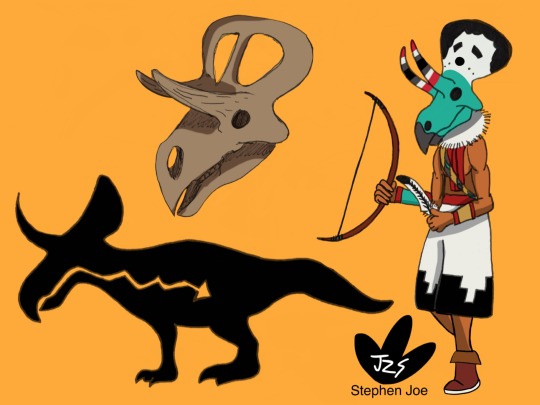
Day 21: Zuniceratops christopheri
Named after the Zuni Pueblo of the southwestern state such as New Mexico, which could make an honorable mention for #Nativember month.
#my art#dinosaur#dinosaurs#paleoart#dinosauria#ornithoscelida#ornithischia#genasauria#neornithischia#cerapoda#marginocephalia#ceratopsia#coronosauria#ceratopsoidea#zuniceratops#Zuni#Zuni Pueblo#southwest#native american heritage month#nativember#draw dinovember#dinovember#sketchbookapp#autodesk sketchbook
7 notes
·
View notes
Text
Diabloceratops eatoni
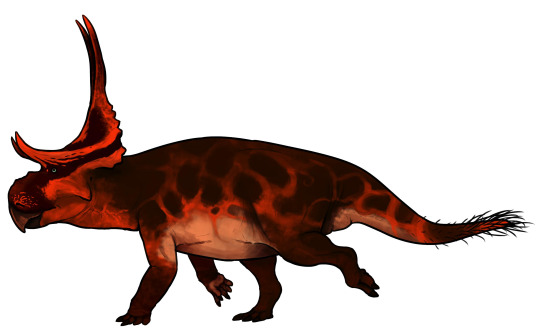
By Jack Wood
Etymology: Devil Horned Face
First Described By: Kirkland et al., 2010
Classification: Dinosauromorpha, Dinosauriformes, Dracohors, Dinosauria, Ornithischia, Genasauria, Neornithischia, Cerapoda, Marginocephalia, Ceratopsia, Neoceratopsia, Coronosauria, Ceratopsoidea, Ceratopsidae, Centrosaurinae?
Status: Extinct
Time and Place: Between 81 and 79 million years ago, in the Campanian of the Late Cretaceous


Diabloceratops is known from the lower and middle members of the Wahweap Formation of Utah

Physical Description: Diabloceratops is one of the most completely visually distinctive Ceratopsids - like all members of this very samey group, its body was the same as the rest of them, but its head was distinctive enough to give it a famous name. Like other Ceratopsids, Diabloceratops had four squat legs, a thick torso, and a short tail. It had a long head, with a large crest and a giant beak in the front of its snout, as well as teeth well built for chewing. The interesting thing about this Ceratopsid is that, while it has small brow horns like most early members of this group, it also had two very noticeable horns coming out of its frills - curving away from each other, the left one curving out to the left and the right one curving out to the right. This gave Diabloceratops the very distinctive look of… well, the Christian depiction of Satan. Hence its name, Devil Horned Face! It had a lightly built skull, with a hole seen in earlier Ceratopsians than the later Ceratopsids, and its head was shorter and deeper than later members. The frill of Diabloceratops was kind of weird too - very tall and narrow, rather than wider as in later Ceratopsians. Diabloceratops was primarily scaly all over, though it is possible (especially given how early derived it was) that it had quills or feathery fluff on its tail like earlier Ceratopsians. It was probably about 5.5 meters long from head to tail.

By Nix, CC BY-NC 4.0
Diet: As a Ceratopsid, Diabloceratops probably fed primarily on plants, though it is possible that it supplemented its diet with meat from time to time for protein. It would focus on low-lying and medium-level plant material, less than a meter in height.
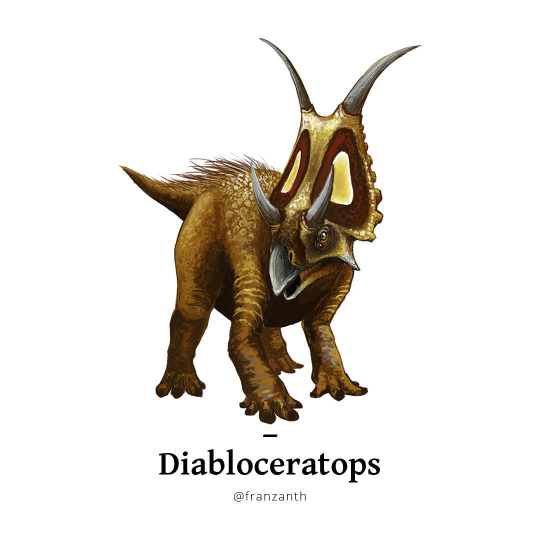
By Franz Anthony
Behavior: The frill and fancy spikes of Diabloceratops would have been primarily used in sexual display and other types of communication between members of the herd, especially since they were rather small all things considered. That being said, other Ceratopsians would use these features for defense, and it is thus likely that Diabloceratops did too, even though they didn’t evolve for such a purpose. Diabloceratops, like other Ceratopsians, would have been a very social animal, spending most of its life in herds with socially complex behavior. These herds would have aided Diabloceratops in defending itself from the local predator Lythronax, and any other predatory animals that may have attempted to attack it. Like other dinosaurs, Diabloceratops probably would have taken care of its young, and the social group would have aided it in doing so. Being a large herbivore with deadly weapons on its face, Diabloceratops would have been a very aggressive animal, not trusting anything that got too close to it or its family. It is possible that Diabloceratops herds also migrated too and from the Western Interior Seaway, based on the seasonal rainfall.

By Sam Stanton
Ecosystem: The Wahweap Formation is one of the earliest environments we know of from the charismatic and iconic Late Cretaceous North American faunas - those ecosystems from the Campanian and Maastrichtian which featured Ceratopsians, Hadrosaurs, and Ankylosaurs a plenty, all being preyed upon by terrifying Tyrannosaurs. Weirdly enough, this unique makeup of these ecosystems is unique to North America - while Hadrosaurs could be found elsewhere somewhat, both Tyrannosaurs and Ceratopsids were very rare elsewhere, Ceratopsids especially so. Instead, the world was frequented with many other kinds of large predatory dinosaurs (especially Abelisaurids), and Titanosaurs were some of the most common large herbivores. But I am getting off track - the Wahweap Formation is one of the earliest of these charismatic locations, and as expected, it has some of the earliest members of these groups to branch off, including Diabloceratops. The Wahweap Formation began as a very dry ecosystem, filled with sand and very brief wet seasons; over time, it became a pond ecosystem and - by the time Diabloceratops disappeared - a very fertile system of rivers running in from the Western Interior Seaway.

By Nathan E. Rogers, used with permission from Studio 252Mya
So, in the time of the earliest part of the formation, Diabloceratops was a living in an extremely seasonally varied environment, as it began to transition to more freshwater being present in later millenia from its earlier dry beginnings. The diversity of the later environments, however, was lacking in the earliest one. Here, Diabloceratops was preyed upon by Lythronax, and while some mammals, turtles, and crocodylomorphs were present, it is entirely possible that the great diversity of mammals and other animals to be found later wasn’t present quite yet. In the middle environment, when the ponds were coming in and things were getting more lush, Lythronax was gone - but now Diabloceratops was accompanied by the Hadrosaur Acristavus, similar to the later Maiasaura. There were many non-dinosaurs too, like turtles, though it is uncertain if the many mammals found in Wahweap are from the middle, lower, or upper parts of this environment.
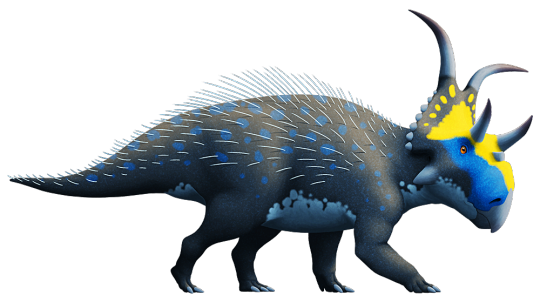
By Nix, CC BY-NC 4.0
Interestingly enough, one of Diabloceratops’ closest relatives, Machairoceratops, is known from the upper unit of this formation - indicating that it is possible that Diabloceratops evolved into Machairoceratops, and never really disappeared from the environment at all.
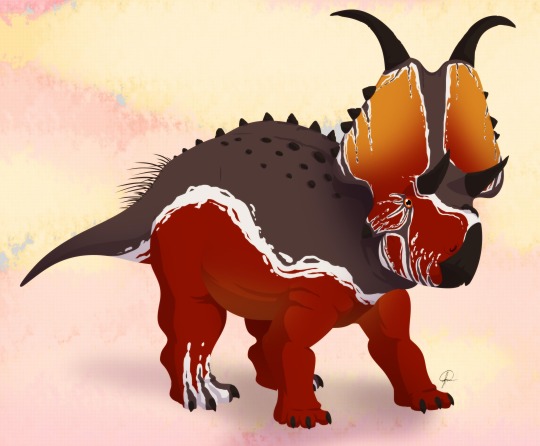
By José Carlos Cortés
Other: Diabloceratops is usually found to be a Centrosaurine, the group of Ceratopsids with prominent nose horns and frill ornamentation, and usually little to no brow horns. However, a very recent analysis of Ceratopsian relationships found Diabloceratops to be neither a Centrosaurine nor a Chasmosarine (the other group of Ceratopsians, which includes Triceratops and its closest relatives), but rather outside both. Either way, Diabloceratops was a very early Ceratopsids, showing characteristics that are often found in common between both of the major groups of these dinosaurs - and showing how weird their headgear got even early on in their evolution.
~ By Meig Dickson
Sources Under the Cut
Chiba, K.; Michael J. Ryan; Federico Fanti; Mark A. Loewen; David C. Evans (2018). "New material and systematic re-evaluation of Medusaceratops lokii (Dinosauria, Ceratopsidae) from the Judith River Formation (Campanian, Montana)". Journal of Paleontology. in press (2): 272–288.
Dalman, Sebastian G.; Hodnett, John-Paul M.; Lichtig, Asher J.; Lucas, Spencer G. (2018). "A new ceratopsid dinosaur (Centrosaurinae: Nasutoceratopsini) from the Fort Crittenden Formation, Upper Cretaceous (Campanian) of Arizona". New Mexico Museum of Natural History and Science Bulletin. 79: 141–164.
De Blieux, Donald D. 2007. Analysis of Jim's hadrosaur site; a dinosaur site in the middle Campanian (Cretaceous) Wahweap Formation of Grand Staircase-Escalante National Monument (GSENM), southern Utah. Abstracts with Programs – Geological Society of America 39 (5): 6.
Eaton, J. G., R. L. Cifelli. 2005. Review of Cretaceous mammalian paleontology; Grand Staircase-Escalante National Monument, Utah. Abstracts with Programs - Geological Society of America 37 (7): 115.
Evans, D. C., and M. J. Ryan. 2015. Cranial anatomy of Wendiceratops pinhornensis gen. et sp. nov., a centrosaurine ceratopsid (Dinosauria: Ornithischia) from the Oldman Formation (Campanian), Alberta, Canada, and the evolution of ceratopsid nasal ornamentation. PLoS ONE 10(7):e0130007
Farke, A. A. 2011. Anatomy and taxonomic status of the chasmosaurine ceratopsid Nedoceratops hatcheri from the Upper Cretaceous Lance Formation of Wyoming, U.S.A. PLoS One 6(1(e16196)):1-9
Farke, A. A., M. J. Ryan, P. M. Barrett, D. H. Tanke, D. R. Braman, M. A. Loewen, and M. R. Graham. 2011. A new centrosaurine from the Late Cretaceous of Alberta, Canada, and the evolution of parietal ornamentation in horned dinosaurs. Acta Palaeontologica Polonica 56(4):691-702
Fiorillo, A. R., and R. S. Tykoski. 2012. A new Maastrichtian species of the centrosaurine ceratopsid Pachyrhinosaurus from the North Slope of Alaska. Acta Palaeontologica Polonica 57(3):561-573
Fowler, D. W. 2017. Revised geochronology, correlation, and dinosaur stratigraphic ranges of the Santonian-Maastrichtian (Late Cretaceous) formations of the Western Interior of North America. PLoS ONE 12 (11): e0188426.
Gates, T.A.; Horner, J.R.; Hanna, R.R.; Nelson, C.R. (2011). "New unadorned hadrosaurine hadrosaurid (Dinosauria, Ornithopoda) from the Campanian of North America". Journal of Vertebrate Paleontology. 31 (4): 798–811.
Gates, Jinnah, Levitt, and Getty, 2014. New hadrosaurid specimens from the lower-middle Campanian Wahweap Formation of southern Utah. pp. 156–173. In The Hadrosaurs: Proceedings of the International Hadrosaur Symposium (D. A. Eberth and D. C. Evans, eds), Indiana University Press, Bloomington.
Getty, M. A., M. A. Loewen, E. M. Roberts, A. L. Titus, and S. D. Sampson. 2010. Taphonomy of horned dinosaurs (Ornithischia: Ceratopsidae) from the late Campanian Kaiparowits Formation, Grand Staircase-Escalante National Monument, Utah. In M. J. Ryan, B. J. Chinnery-Allgeier, D. A. Eberth (eds.), New Perspectives on Horned Dinosaurs: The Royal Tyrrell Museum Ceratopsian Symposium. Indiana University Press, Bloomington 478-494
Hone, D.W.E.; Naish, D.; Cuthill, I.C. (2011). “Does mutual sexual selection explain the evolution of head crests in pterosaurs and dinosaurs?” (PDF). Lethaia. 45 (2): 139–156.
Glut, D. F., 2012, Dinosaurs, the Encyclopedia, Supplement 7: McFarland & Company, Inc, 866pp.
Kentaro Chiba; Michael J. Ryan; Federico Fanti; Mark A. Loewen; David C. Evans (2018). "New material and systematic re-evaluation of Medusaceratops lokii (Dinosauria, Ceratopsidae) from the Judith River Formation (Campanian, Montana)". Journal of Paleontology. in press (2): 272–288.
Kirkland, J. I. 2005. An inventory of paleontological resources in the lower Wahweap Formation (lower Campanian), southern Kaiparowits Plateau, Grand Staircase-Escalante National Monument, Utah. Abstracts with Programs - Geological Society of America 37 (7): 114.
Kirkland, J. I., and D. D. DeBlieux. 2007. New horned dinosaurs from the Wahweap Formation, Grand Staircase-Escalante National Monument, southern Utah. Utah Geological Survey Notes 39(3):4-5
Kirkland, J. I., and D. D. Deblieux. 2010. New basal centrosaurine ceratopsian skulls from the Wahweap Formation (middle Campanian), Grand Staircase-Escalante National Monument, southern Utah. New Perspectives on Horned Dinosaurs: The Royal Tyrrell Museum Ceratopsian Symposium. Indiana University Press, Bloomington 117-140
Loewen, M. A., R. B. Irmis, J. J. W. Sertich, P. J. Currie, and S. D. Sampson. 2013. Tyrant dinosaur evolution tracks the rise and fall of Late Cretaceous oceans. PLoS ONE 8(11):e79420
Lund, E. K., P. M. O'Connor, M. A. Loewen and Z. A. Jinnah. 2016. A new centrosaurine ceratopsid, Machairoceratops cronusi gen et sp. nov., from the Upper Sand Member of the Wahweap Formation (Middle Campanian), southern Utah. PLoS ONE 11(5):e0154403:1-21
Mallon, Jordan C; David C Evans; Michael J Ryan; Jason S Anderson (2013). [tp://link.springer.com/article/10.1186/1472-6785-13-14 “Feeding height stratification among the herbivorous dinosaurs from the Dinosaur Park Formation (upper Campanian) of Alberta, Canada”]. BMC Ecology. 13: 14.
Orsulak, M. 2007. A lungfish burrow in late Cretaceous upper capping sandstone member of the Wahweap Formation Cockscomb area, Grand Staircase-Escalante National Monument, Utah. Abstracts with Programs - Geological Society of America 39 (5): 43.
Sampson, S. D., 2001, Speculations on the socioecology of Ceratopsid dinosaurs (Orinthischia: Neoceratopsia): In: Mesozoic Vertebrate Life, edited by Tanke, D. H., and Carpenter, K., Indiana University Press, pp. 263–276.
Simpson, Edward L.; Hilbert-Wolf, Hannah L.; Wizevich, Michael C.; Tindall, Sarah E.; Fasinski, Ben R.; Storm, Lauren P.; Needle, Mattathias D. (2010). "Predatory digging behavior by dinosaurs". Geology. 38 (8): 699–702.
Tester, E. 2007. Isolated vertebrate tracks from the Upper Cretaceous capping sandstone member of the Wahweap Formation; Grand Staircase-Escalante National Monument, Utah. Abstracts with Programs - Geological Society of America 39 (5): 42.
Thompson, C. R. 2004. A preliminary report on biostratigraphy of Cretaceous freshwater rays, Wahweap Formation and John Henry Member of the Straight Cliffs Formation, southern Utah. Abstracts with Programs - Geological Society of America 36 (4): 91.
Weishampel, David B; et al. (2004). "Dinosaur distribution (Late Cretaceous, North America)." In: Weishampel, David B.; Dodson, Peter; and Osmólska, Halszka (eds.): The Dinosauria, 2nd, Berkeley: University of California Press. Pp. 574–588.
Williams, J. A. J., C. F. Lohrengel. 2007. Preliminary study of freshwater gastropods in the Wahweap Formation, Bryce Canyon National Park, Utah. Abstracts with Programs - Geological Society of America 39 (5): 43.
Zubair A. Jinnah, #30088 (2009)Sequence Stratigraphic Control from Alluvial Architecture of Upper Cretaceous Fluvial System - Wahweap Formation, Southern Utah, U.S.A. Search and Discovery Article #30088. Posted June 16, 2009.
#Diabloceratops eatoni#Diabloceratops#Dinosaur#Ceratopsian#Palaeoblr#Factfile#Ceratopsid#Mesozoic Monday#Herbivore#Cretaceous#North America#paleontology#prehistory#prehistoric life#dinosaurs#biology#a dinosaur a day#a-dinosaur-a-day#dinosaur of the day#dinosaur-of-the-day#science#nature
410 notes
·
View notes
Photo

Albertoceratops
Length: 5 m
Weight: 1 t
Place of occurrence: Canada - the province of Alberta
(Oldman formation)
Duration of occurrence 77 - 72 Ma
late chalk (campan)
Systematics of Dinosauria
Ornithischia
Genasauria
Cerapoda
Marginocephalia
Ceratopsia
Neoceratopsia
Coronosauria
Ceratopsoidea
Ceratopsidae
Centrosaurinae
Więcej o tekście źródłowymWskaż tekst źródłowy, by wyświetlić dodatkowe informacje o tłumaczeniu
Prześlij opinię
Panele boczne
2 notes
·
View notes
Text
Nasutoceratops titusi

By Scott Reid
Etymology: Large-Nosed Horned-Face
First Described By: Sampson et al., 2013
Classification: Dinosauromorpha, Dinosauriformes, Dracohors, Dinosauria, Ornithischia, Genasauria, Neornithischia, Cerapoda, Marginocephalia, Ceratopsia, Neoceratopsia, Coronosauria, Ceratopsoidea, Ceratopsidae, Centrosaurinae, Nasutoceratopsini
Status: Extinct
Time and Place: Between 76 and 75.6 million years ago, in the Campanian age of the Late Cretaceous


Nasutoceratops is known from the middle member of the Kaiparowits Formation in Utah
Physical Description: Nasutoceratops is a Ceratopsian - so, as with all Ceratopsians, it has an extremely distinctive head! Like other Ceratopsians, it would have been around 5 meters long or so, and had a very bulky body with a short, skinny tail. The legs of this dinosaur - as in others of its kind - were short, bulky, and had very padded and thick toes that made running easy for this animal. The really distinctive aspects of this dinosaur, however, were in its head - again, as in other Ceratopsians, which might as well all be Mr. Potato Heads with the different combinations of horns and frills as the exchangeable parts of the classic toy. Nasutaceratops sported a short frill, a short and high snout, and distinctively long horns. The horns on its brow were more horizontal than most, but they curved inward like those found on modern cattle! The nostril did not feature a horn, but was very high and ridged instead. Interestingly enough, there were extensive cavities in this rounded nose that may have been pneumatic, giving Nasutoceratops a very unique trait compared to other Ceratopsians. It had a very thickly overlapping upper jaw, which would have made it somewhat less flexible than other Ceratopsians. The frill had small round osteoderms all around the edge, and there isn’t a notch on the frill like in other Ceratopsians. As in its relatives, Nasutoceratops would have probably been primarily scaly, though it may have had feather-quills on the edge of its tail or elsewhere on its body. The frill would have probably been brightly colored, for display.
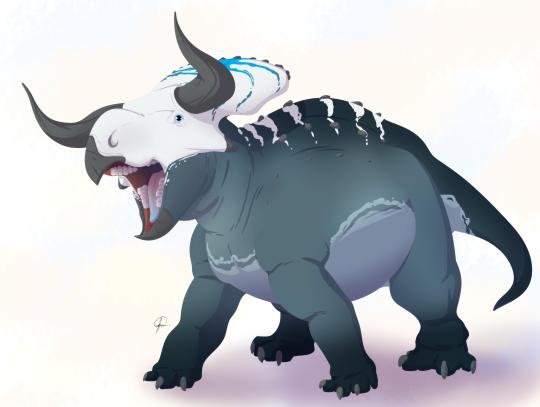
By José Carlos Cortés
Diet: Nasutoceratops would have primarily been an herbivore, feeding on low-lying and medium-level leaves and other plant material, all less than one meter tall.
Behavior: Nasutoceratops, like other Ceratopsians, would have been a very social creatures! These dinosaurs would have spent a lot of time together roaming their home in large herds, and used their frills and fancy horns to display to one another for communication and mating displays. This points back to their fairly complicated social groupings, where the young would have been protected by the adults from oncoming danger. The horns would have also been useful in telling apart Nasutaceratops from other dinosaurs that lived with it, such as the Chasmosaurine Ceratopsian Kosmoceratops. Like other dinosaurs, it would have been warm-blooded, and thus needed to spend a good chunk of the day finding food. It also may have fought with its horns, though that’s somewhat more controversial, especially given their odd shape - though a combination of the bumpy nose and horns . These horns may have had sheaths of fingernail material (keratin) over them, making them longer, but probably not more available for fighting. The colors of the frill may have been able to change, giving even more communication ability. These structures - the frills and horns - wouldn’t have been prominent in baby Nasutoceratops, but grew with the animal as it aged into sexual maturity. Nasutoceratops would have taken care of its young, which would eventually join the herd with the adults.
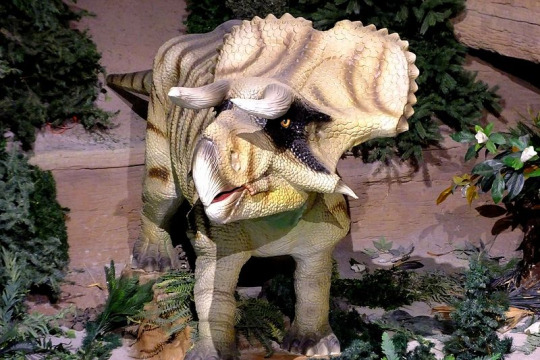
By Kathy Neenan, CC BY-SA 4.0
Ecosystem: Nasutoceratops lived in the Kaiparowits Formation, which would have been a very muddy jungle ecosystem, with a wide variety of animals living very near the Western Interior Seaway. A variety of swamps, ponds, and lakes frequented the entire area, which was surrounded on its other side by highlands and mountains, enclosing it against the sea. It was a very wet and humid environment, allowing for high animal diversity. Among those that lived with Nasutoceratops include other Ceratopsians like Kosmoceratops and Utahceratops, hadrosaurs like Gryposaurus and Parasaurolophus, the ankylosaur Akainacephalus, the Troodontid Talos, the Ornithomimid Ornithomimus, the Oviraptor Hagryphus, and the opposite bird Mirarce! That being said, the main predator of Nasutoceratops would definitely have been the local Tyrannosaur, Teratophoneus. There were also a variety of mammals, turtles, and Neosuchians in the environment, which all took advantage of the wet swampy conditions.

By Ripley Cook
Other: Nasutoceratops was a Centrosaurine, those Ceratopsians more closely related to the likes of Styracosaurus than to Triceratops. Interestingly enough, these Ceratopsians tend to do more weird stuff with their noses - usually giant horns, but Nasutoceratops seems to have gone for a more lightweight option. In fact, Nasutoceratops gave its name to a whole group of these animals, which retained the brow horns of the ancestral ceratopsians (where other Centrosaurines lost them).
~ By Meig Dickson
Sources Under the Cut
Atterholt, J.; J. Howard Hutchison; Jingmai K. O’Connor (2018). "The most complete enantiornithine from North America and a phylogenetic analysis of the Avisauridae". PeerJ. 6: e5910.
Chiba, K., M. J. Ryan, F. Fanti, M. A. Loewen. D. C. Evans. 2018. New material and systematic re-evaluation of Medusaceratops lokii (Dinosauria, Ceratopsidae) from the Judith River Formation (Campanian, Montana). Journal of Paleontology 92 (2): 272-288.
Eaton, Jeffrey G.; Cifelli, Richard L.; Hutchinson, J. Howard; Kirkland, James I.; Parrish, J. Michael (1999). "Cretaceous vertebrate faunas from the Kaiparowits Plateau, south-central Utah". In Gillete, David D. (ed.). Vertebrate Paleontology in Utah. Miscellaneous Publication 99-1. Salt Lake City: Utah Geological Survey. pp. 345–353.
Eaton, J.G., 2002. Multituberculate mammals from the Wahweap(Campanian, Aquilan) and Kaiparowits (Campanian, Judithian)formations, within and near Grand Staircase-Escalante NationalMonument, southern Utah. Miscellaneous Publication 02-4, UtahGeological Survey, 66 pp.
Fowler, D. W. 2017. Revised geochronology, correlation, and dinosaur stratigraphic ranges of the Santonian-Maastrichtian (Late Cretaceous) formations of the Western Interior of North America. PLoS ONE 12 (11): e0188426.
Getty, M. A., M. A. Loewen, E. M. Roberts, A. L. Titus, and S. D. Sampson. 2010. Taphonomy of horned dinosaurs (Ornithischia: Ceratopsidae) from the late Campanian Kaiparowits Formation, Grand Staircase-Escalante National Monument, Utah. In M. J. Ryan, B. J. Chinnery-Allgeier, D. A. Eberth (eds.), New Perspectives on Horned Dinosaurs: The Royal Tyrrell Museum Ceratopsian Symposium. Indiana University Press, Bloomington 478-494
Hone, D.W.E.; Naish, D.; Cuthill, I.C. (2011). “Does mutual sexual selection explain the evolution of head crests in pterosaurs and dinosaurs?” (PDF). Lethaia. 45 (2): 139–156.
Lund, E. K. (2010). "Nasutuceratops titusi, a new basal centrosaurine dinosaur (Ornithischia: Ceratopsidae) from the upper cretaceous Kaiparowits Formation, Southern Utah". Department of Geology and Geophysics University of Utah: 172 pp.
Mallon, Jordan C; David C Evans; Michael J Ryan; Jason S Anderson (2013). [tp://link.springer.com/article/10.1186/1472-6785-13-14 "Feeding height stratification among the herbivorous dinosaurs from the Dinosaur Park Formation (upper Campanian) of Alberta, Canada"]. BMC Ecology. 13: 14.
Roberts EM, Deino AL, Chan MA (2005) 40Ar/39Ar age of the Kaiparowits Formation, southern Utah, and correlation of contemporaneous Campanian strata and vertebrate faunas along the margin of the Western Interior Basin. Cretaceous Res 26: 307–318.
Roberts EM, Sampson SD, Deino AL, Bowring S, Buchwaldt R. The Kaiparowits Formation: a remarkable record of Late Cretaceous terrestrial environments, ecosystems and evolution in western North America. In: Titus AL, Loewen MA, editors. At the Top of the Grand Staircase: The Late Cretaceous of Southern Utah. Bloomington, Indiana: Indiana University Press; 2013. p. 85–106.
Ryan, M.J.; Holmes, R.; Mallon, J.; Loewen, M.; Evans, D.C. (2017). "A basal ceratopsid (Centrosaurinae: Nasutoceratopsini) from the Oldman Formation (Campanian) of Alberta, Canada". Canadian Journal of Earth Sciences. 54.
Sampson, S. D., 2001, Speculations on the socioecology of Ceratopsid dinosaurs (Orinthischia: Neoceratopsia): In: Mesozoic Vertebrate Life, edited by Tanke, D. H., and Carpenter, K., Indiana University Press, pp. 263–276.
Sampson, S. D., M. A. Loewen, A. A. Farke, E. M. Roberts, C. A. Forster, J. A. Smith, and A. L. Titus. 2010. New horned dinosaurs from Utah provide evidence for intracontinental dinosaur endemism. PLoS One 5(9):e12292:1-12.
Sampson, S. D.; Lund, E. K.; Loewen, M. A.; Farke, A. A.; Clayton, K. E. (2013). "A remarkable short-snouted horned dinosaur from the Late Cretaceous (late Campanian) of southern Laramidia". Proceedings of the Royal Society B: Biological Sciences. 280 (1766): 20131186.
Tanke, D.H. and Brett-Surman, M.K. 2001. Evidence of Hatchling and Nestling-Size Hadrosaurs (Reptilia:Ornithischia) from Dinosaur Provincial Park (Dinosaur Park Formation: Campanian), Alberta, Canada. pp. 206–218. In: Mesozoic Vertebrate Life—New Research Inspired by the Paleontology of Philip J. Currie. Edited by D.H. Tanke and K. Carpenter. Indiana University Press: Bloomington. xviii + 577 pp.
Titus, Alan L. and Mark A. Loewen (editors). At the Top of the Grand Staircase: The Late Cretaceous of Southern Utah. 2013. Indiana University Press. Hardbound: 634 pp.
Weishampel, David B.; Dodson, Peter; and Osmólska, Halszka (eds.): The Dinosauria, 2nd, Berkeley: University of California Press. 861 pp.
Wiersma, J. P.; Randall B. Irmis (2018). "A new southern Laramidian ankylosaurid, Akainacephalus johnsoni gen. et sp. nov., from the upper Campanian Kaiparowits Formation of southern Utah, USA". PeerJ. 6: e5016.
Zanno, Lindsay E.; Sampson, Scott D. (2005). "A new oviraptorosaur (Theropoda; Maniraptora) from the Late Cretaceous (Campanian) of Utah". Journal of Vertebrate Paleontology. 25 (4): 897–904.
Zanno, L.E., Weirsma, J.P., Loewen, M.A., Sampson, S.D. and Getty, M.A. (2010). A preliminary report on the theropod dinosaur fauna of the late Campanian Kaiparowits Formation, Grand Staircase-Escalante National Monument, Utah.[permanent dead link]" Learning from the Land Symposium: Geology and Paleontology. Washington, DC: Bureau of Land Management.
Zanno, L. E.; David J. Varricchio; Patrick M. O'Connor; Alan L. Titus; Michael J. Knell (2011). "A new troodontid theropod, Talos sampsoni gen. et sp. nov., from the Upper Cretaceous Western Interior Basin of North America". PLoS ONE. 6 (9): e24487.
#Nasutoceratops titusi#Nasutoceratops#Dinosaur#Ceratopsian#Palaeoblr#Factfile#Prehistoric Life#Mesozoic Monday#Herbivore#North America#Cretaceous#Paleontology#Prehistory#Dinosaurs#Dinosaur of the day#A Dinosaur A Day#A-Dinosaur-A-Day#Dinosaur-of-the-Day#nature#biology#science
313 notes
·
View notes
Text
Polyonax mortuarius

By José Carlos Cortés
Etymology: Master over Many
First Described By: Cope, 1874
Classification: Dinosauromorpha, Dinosauriformes, Dracohors, Dinosauria, Ornithischia, Genasauria, Neornithischia, Cerapoda, Marginocephalia, Ceratopsia, Neoceratopsia, Coronosauria, Ceratopsoidea, Ceratopsidae
Status: Extinct
Time and Place: Around 66 million years ago, in the Maastrichtian of the Late Cretaceous


Polyonax is known from the Lower Denver Formation in Colorado

Physical Description: Polyonax was some sort of Ceratopsian, a quadrupedal herbivorous dinosaur with a frill over its neck and a stout beak in the front of its mouth. It would have had a shorter tail and somewhat squat legs. Beyond that, we know very little about it. We have the vertebrae and some of the horn cones, which show us that it was a subadult that had horns on its face of some sort. It might have resembled Triceratops and its kind, but even that is a question. It would have been mainly scaly, though some tail quills is not out of the question.
Diet: As a Ceratopsian, Polyonax would have primarily fed upon mid-level and lower-lying plants, as well as possibly supplementing its diet with meat and other sources of food when necessary.
Behavior: It is difficult to say what the behavior of Polyonax was without more fossil evidence. Fights between members of the species using the horns would have probably occurred, for mates and territory and food. They also would have probably defended themselves from predators using the horns. The frills would have been distinctly patterned and brightly colored, for communication between members of the species. It probably would have been a very active animal, living in social groups and taking care of its young. But even then, all of these are guesses.
Ecosystem: The Denver Formation was a flooded river pain, with a wide variety of braided rivers stemming down to the nearby Inland Sea. This was an area filled with marshes and thick water plants, with sandy and muddy shores that would have been hard to get through. It was also extremely heavy on trees, and in general a very lush sub-tropical forest environment. There were probably regular volcanic explosions as well. The plant life was diverse - with ferns and magnolias, ficuses and clubmosses, palms and more flowering plants - pointing to the sub-tropical marsh environment that Polyonax lives in. There were a wide variety of turtles living in this lush place, as well as mammals. It was also cozy little dinosaur community, with hadrosaurs like Edmontosaurus, the dome-headed Pachycephalosaurus, the ostrich-mimic Ornithomimus, and the large predator Tyrannosaurus that would have been the main danger for Polyonax. In terms of other Ceratopsians, there was Triceratops - which may or may not be the same thing as Polyonax in the end.
Other: Because Polyonax was described such a long time ago and from such poor remains, it is a nomen dubium - a dubious genus of dinosaur. The material isn’t good enough to say it’s definitely the same as another dinosaur, but it also isn’t good enough to say it is definitely some sort of unique dinosaur. As such, it can’t be eliminated as a genus, nor really talked about in anything resembling detail. So that’s annoying! Yay science.
~ By Meig Dickson
Sources under the Cut
Carpenter, K. and Young, D.B. 2002. Late Cretaceous dinosaurs from the Denver Basin, Colorado. Rocky Mountain Geology, vol. 37, p. 237-254.
Cope, E.D. (1874). Report on the stratigraphy and Pliocene vertebrate paleontology of northern Colorado. Bulletin of the U.S. Geological and Geographical Survey of the Territories. 9:9-28.
Dodson, P. (1996). The Horned Dinosaurs. Princeton University Press:Princeton, New Jersey.
Dodson, P., Forster, C.A., and Sampson, S.D. (2004). Ceratopsidae. In: Weishampel, D.B., Dodson, P., and Osmólska, H. (eds.). The Dinosauria (second edition). University of California Press:Berkeley, 494-513.
Eberle, J.J. 2003. Puercan mammalian systematics and biostratigraphy in the Denver Formation, Denver Basin, Colorado. Rocky Mountain Geology, vol. 38, no. 1. p. 143-169.
Emmons, S.F., Cross, W. and Eldridge, G.H. 1896. Geology of the Denver Basin in Colorado. U.S. Geological Survey, Monograph 27, p. 160.
Glut, D.F. (1997). "Polyonax". Dinosaurs: The Encyclopedia. McFarland & Company. pp. 723–724.
Hatcher, J.B. (1902). The genus and species of the Trachodontidae (Hadrosauridae, Claosauridae) Marsh. Annals of the Carnegie Museum 14(1):377-386.
Hatcher, J.B., Marsh, O.C., and Lull, R.S. (1907). The Ceratopsia. Government Printing Office:Washington, D.C., 300 pp.
Hutchison, J.H. and Holroyd, P.A. 2003. Late Cretaceous and early Paleocene turtles of the Denver Basin, Colorado. Rocky Mountain Geology, vol. 38, no. 1, p. 121-142.
Johnson, K.R., Reynolds, M.L., Werth, K.W., and Thomasson, J.R. 2003. Overview of the Late Cretaceous, early Paleocene, and early Eocene megafloras of the Denver Basin, Colorado. Rocky Mountain Geology, vol. 38, no. 1, p. 101-120.
Kauffman, E.G., Upchurch, G.R. Jr., and Nichols, D.J., 2005. The Cretaceous-Tertiary boundary at South Table Mountain near Golden, Colorado. In: Extinction Events in Earth History, Lecture Notes in Earth Sciences, vol. 30, p. 365-392.
Kile D.E., 2004. Zeolites and associated minerals from the Table Mountains near Golden, Jefferson County, Colorado. Rocks and Minerals, vol. 79, no. 4, p. 218-238.
Lambert, D., and the Diagram Group. (1990). The Dinosaur Data Book. Facts on File:Oxford, England, 320 p.
Raynolds, R.G. 2002. Upper Cretaceous and Tertiary stratigraphy of the Denver Basin, Colorado. Rocky Mountain Geology, vol. 37, no. 2, p. 111-134.
Raynolds, R.G. and Johnson, K.R. 2003. Synopsis of the stratigraphy and paleontology of the uppermost Cretaceous and lower Tertiary strata in the Denver Basin, Colorado. Rocky Mountain Geology, vol. 38, no. 1, p. 171-181.
Romer, A.S. (1956). Osteology of the Reptiles. University of Chicago Press:Chicago, 1-772.
Tweto, O. 1979. Geologic map of Colorado. U.S. Geological Survey, Map G77115.
Van Horn, R. 1957. Bedrock geology of the Golden Quadrangle, Colorado. U.S. Geological Survey, Map GQ-103.
Weishampel, David B.; Dodson, Peter; and Osmólska, Halszka (eds.): The Dinosauria, 2nd, Berkeley: University of California Press. 861 pp.
Weishampel, David B; et al. (2004). "Dinosaur distribution (Late Cretaceous, North America)." In: Weishampel, David B.; Dodson, Peter; and Osmólska, Halszka (eds.): The Dinosauria, 2nd, Berkeley: University of California Press. Pp. 574-588.
#Polyonax mortuarius#Polyonax#Ceratopsian#Dinosaur#Palaeoblr#Factfile#Prehistoric Life#Paleontology#Prehistory#Mesozoic Monday#Herbivore#Cretaceous#North America#dinosaurs#biology#a dinosaur a day#a-dinosaur-a-day#dinosaur of the day#dinosaur-of-the-day#science#nature
83 notes
·
View notes
Text
Ceratops montanus
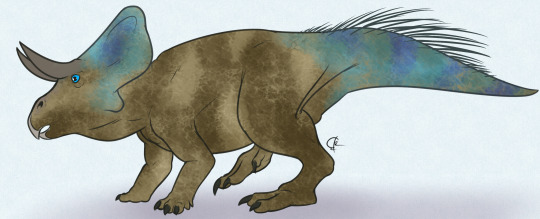
By José Carlos Cortés (@here)
Etymology: Horn Face
First Described By: Marsh, 1888
Classification: Dinosauromorpha, Dinosauriformes, Dracohors, Dinosauria, Ornithischia, Genasauria, Neornithischia, Cerapoda, Marginocephalia, Ceratopsia, Neoceratopsia, Coronosauria, Ceratopsoidea, Ceratopsidae
Status: Extinct
Time and Place: Ceratops lived sometime between 76.17 and 75.21 million years ago, in the Campanian age of the Late Cretaceous


Ceratops was found in the Coal Ridge Member of the Judith River Formation in the state of Montana in the United States
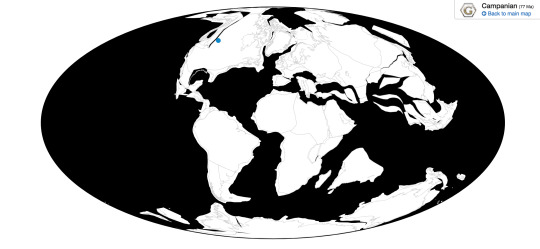
Physical Description: Ceratops, being known only from the end of the skull and some horns, is difficult to describe accurately. As a ceratopsian, it would have been a quadrupedal herbivore. Ceratops would have probably sported a thick tail, a frill on the back of its head, and definitely had horns - like other Ceratopsians. It also would have had a beak in the front of its mouth, and rows of teeth in the back. Beyond that, we do not know much. The horns themselves are about twenty-two centimeters in length, which is quite small, compared to animals like Triceratops. This may mean that Ceratops itself was small, or that it had small horns. We cannot know. We can tell, however, that these horns were attached to the top of the head - they weren’t the short horns of the nose, so the size of the animal remains a question.
Diet: As a ceratopsian, Ceratops would have probably eaten mainly plants. The beak would have aided Ceratops in snipping off plant material, which it then would chew with its rows of teeth - these rows functioned by slicing against each other, sort of like highly serrated scissors. It was restricted mostly to food at about one meter high, making it a low browser. Like other herbivores, it’s possible that it supplemented its diet with scavenged meat for protein.
Behavior: Ceratopsians were herding animals, and Ceratops would have been no exception. The frills and horns of these species were used primarily for communication (through display) in these herds, but not as species recognition nor as methods of sexual display. Still, they probably were attractive to other members of the species, and used in sexual display. Given we don’t know much about what the horns and frill of Ceratops looked like, it’s difficult to determine exactly if the horns and frill would have also been able to double as defensive structures - though the horns were small, they may have been proportionally so, or extended with keratin (the same material found in your nails, just made with a different specific protein). Other than that, much of its behavior would have been dependent on its size, which we do not know.
Ecosystem: Ceratops is from the Judith River Formation, a complex community of animals that showcase the unique environment that was present in North America during the Late Cretaceous. While most of the world looked similar to most of the rest of the Mesozoic era - with large Sauropods, smaller other herbivores, and a variety of different predatory dinosaurs - North America was unique in that it really didn’t have any sauropods (Alamosaurus notwithstanding), and instead was populated by a mind-boggling diversity of Ceratopsians, Hadrosaurs, and Ankylosaurs. Thus, North America - the system with which we are all most familiar because of the history of paleontology itself - is actually the weird outlier, the Australia of its day.
The Judith River Formation was one of these weird locations, The Coal Ridge Member - within which Ceratops was found - represents a specific snapshot of this ecosystem. This environment was part of a coastal plain near the Western Interior Seaway, a large sea that extended through the middle of North America at the time. This would have been a very flat, low-lying ecosystem, closely tied to the water’s edge. Ceratopsians especially were very common and associated with this waterway.
Ceratops lived alongside many other kinds of dinosaurs here - other ceratopsians such as Mercuriceratops and Spiclypeus, the ankylosaurs Zuul and Edmontonia and Panoplosaurus, a variety of poorly preserved other herbivorous dinosaurs, some sort of Hadrosaur, and a tyrannosaur similar to Albertosaurus. Tyrannosaurs are usually the principle predators of Ceratopsians, and Ceratops was probably preyed upon by whichever tyrannosaur this was.
Other: Ceratops has had a long and complex taxonomical history due to its unfortunate luck of being an early named dinosaur. Still, it is thanks to Ceratops that we have the name for the entire group of horned dinosaurs, Ceratopsia.
~ By Meig Dickson
Sources under the cut
Arbour, V. M., D. C. Evans. 2017. A new ankylosaurine dinosaur from the Judith River Formation of Montana, USA, based on an exceptional skeleton with soft tissue preservation. Royal Society Open Science 4(161086).
Brinkman, D. B. 1990. Paleoecology of the Judith River Formation (Campanian) of Dinosaur Provincial Park, Alberta, Canada: Evidence from vertebrate microfossil localities. Palaeogeography, Palaeoclimatology, Palaeoecology 78 (1-2): 37 - 54.
Fowler, D. W. 2017. Revised Geochronology, Correlation, and Dinosaur Stratigraphic Ranges of the Santonian-Maastrichtian (Late Cretaceous) formations of the Western Interior of North America. PLoS One 12 (11): e0188426.
Hatcher, J. B., O. C. Marsh, R. S. Lull. 1907. The Ceratopsia. Monographs of the United States Geological Survey 49: 198.
Knapp, A., R. J. Knell, A. A. Farke, M. A. Loewen, D. W. E. Hone. 2018. Patterns of divergence in the morphology of ceratopsian dinosaurs: sympatry is not a driver of ornament evolution. Proceedings of the Royal Society B: Biological Sciences 285 (1875): 20180312.
Mallon, J. C., C. J. Ott, P. L. Larson, E. M. Iuliano, D. C. Evans. 2016. Spiclypeus shipporum gen. et sp. nov., a boldly audacious new chasmosaurine ceratopsid (Dinosauria: Ornithischia) from the Judith River Formation (Upper Cretaceous: Campanian) of Montana, USA. PLoS ONE 11 (5): e0154218: 1-40.
Malton, J. C., D. C. Evans, M. J. Ryan, J. S. Anderson. 2013. Feeding height stratification among the herbivorous dinosaurs from the Dinosaur Park Formation (Upper Campanian) of Alberta, Canada. BMC Ecology 13: 14.
Marsh, O. C. 1888. A new family of horned Dinosauria, from the Cretaceous. The American Journal of Science 3 (36): 477 - 478.
Ryan, M. J., D. C. Evans, P. J. Currie, M. A. Lowman. 2014. A new chasmosaurine from northern Laramidia expands fill disparity in ceratopsid dinosaurs. Naturwissenchaften 101: 505-512.
Sampson, S. D. 2001. Speculations on the socioecology of Ceratopsid dinosaurs (ORnithischia: Neoceratopsia). ITanke, D. H., Carpenter, K (eds.) Mesozoic Vertebrate Life. Indiana University Press: 263 - 276.
Storer, J. E. 1993. Additions to the mammalian paleofauna of Saskatchewan. Modern Geology 18(4): 475-487
#ceratops#dinosaur#ceratopsid#ceratopsian#ceratops montanus#paleontology#palaeoblr#dinosaurs#herbivore#mesozoic monday#north america#cretaceous#factfile#prehistory#prehistoric life#biology#a dinosaur a day#a-dinosaur-a-day#dinosaur of the day#dinosaur-of-the-day#science#nature
117 notes
·
View notes
Text
Yehuecauhceratops mudei
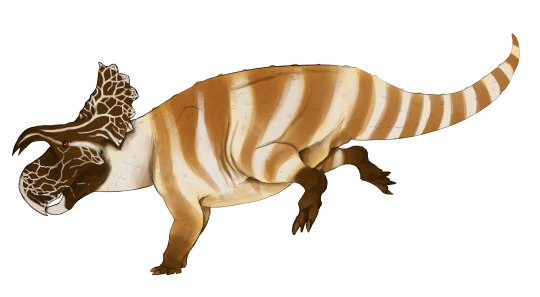
By Jack Wood on @thewoodparable
PLEASE SUPPORT US ON PATREON. EACH and EVERY DONATION helps to keep this blog running! Any amount, even ONE DOLLAR is APPRECIATED! IF YOU ENJOY THIS CONTENT, please CONSIDER DONATING!
Name: Yehuecauhceratops mudei
Name Meaning: Ancient Horned Face
First Described: 2017
Described BY: Rivera-Sylva et al.
Classification: Dinosauria, Ornithischia, Genasauria, Neornithischia, Cerapoda, Marginocephalia, Ceratopsia, Neoceratopsia, Coronosauria, Ceratopsoidea, Ceratopsidae, Centrosaurinae, Nasutoceratopsini
Yehuecauhceratops is a recently described Centrosaurine from the Aguja Formation in Mexico, living in the Campanian age of the Late Cretaceous, about 72 million years ago. It was a very small Centrosaurine, about 3 meters long, and closely related to Avaceratops and Nasutoceratops, and was quite similar to Avaceratops in morphology. It is known from multiple specimens from various parts of the body. It lived in a freshwater to brackish coastal marsh and floodplain in a river delta, near the coast of the inland sea. It lived alongside Agujaceratops, Kritosaurus, Texacephale, and Richardoestesia. It also represents a rare example of a Centrosaurine from south of Colorado.
Source:
https://en.wikipedia.org/wiki/Yehuecauhceratops
Shout out goes to @chloemariecollins!
#yehuecauhceratops#yehuecauhceratops mudei#dinosaur#ceratopsian#palaeoblr#chloemariecollins#paleontology#prehistory#prehistoric life#dinosaurs#biology#a dinosaur a day#a-dinosaur-a-day#dinosaur of the day#dinosaur-of-the-day#science#nature#factfile#Dìneasar#डायनासोर#ديناصور#ডাইনোসর#risaeðla#ڈایناسور#deinosor#恐龍#恐龙#динозавр#dinosaurio#공룡
54 notes
·
View notes
Text
Triceratops horridus, T. prorsus
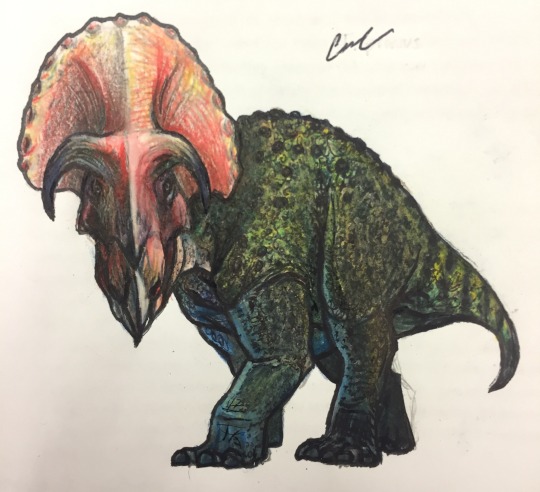
By Cameron Clow, on @darktanion and who can be found professionally here at http://cameronclow.weebly.com/!
PLEASE support us on Patreon! We really do need all of your support to keep this blog running - any amount helps!
Name: Triceratops horridus, T. prorsus
Name Meaning: Three Horn Face
First Described: 1889
Described By: Marsh
Classification: Dinosauria, Ornithischia, Genasauria, Neornithischia, Cerapoda, Marginocephalia, Ceratopsia, Neoceratopsia, Coronosauria, Ceratopsoidea, Ceratopsidae, Chasmosaurinae, Triceratopsini
Behold - one of the most well known of non-avian Dinosaur genera. Triceratops lived about 68 to 66 million years ago, in the Maastrichtian age of the Late Cretaceous, making it one of the last Non-avian dinosaurs to have lived - and it certainly was unique among Ceratopsians, reaching extremely large sizes and having strange bodily proportions. It was about 7.9 to 9.0 meters long, and up to 2.9 to 3 meters in height. It probably would have weighed somewhere between 6 and 12 tonnes, but this is still under scrutiny (as most weight measurements are).

By Scott Reid on @drawingwithdinosaurs
There are two species - and yes, both of them are valid for once - with T. horridus mainly different from T. prorsus due to having a shallower snout, as well as being from different times in history (for the most part). They were very stocky and study, and though when I was a kid it was highly debated whether or not the front limbs would have had to sprawl, it has been concluded nowadays that, indeed, the front limbs would have been positioned under the body, with the elbows flexed and only slightly bowed out like in modern rhinoceros.

By Matt Martyniuk, CC BY-SA 4.0
Given that it could not pronate it’s hands, like other dinosaurs, it had a unique strategy for walking on all fours - it walked with it’s fingers pointing out away from the body, like in other Ceratopsians and in quadrupedal Ornithopods. It is also known to have scale impressions which are, as yet, unpublished; however, these skin impressions are truly unlike anything else we’ve seen in other Ceratopsians, with a network of large hexagonal tubercules and conical projections. It is uncertain what these structures would have represented in life, and they do not rule out feather bristles (as seen on Psittacosaurus, a distant relative); so the jury is still out on what, exactly, the integument of Triceratops was, and, obviously, more published research is required; for now, scales are a definite, and quills and other structures are possible in addition to them.
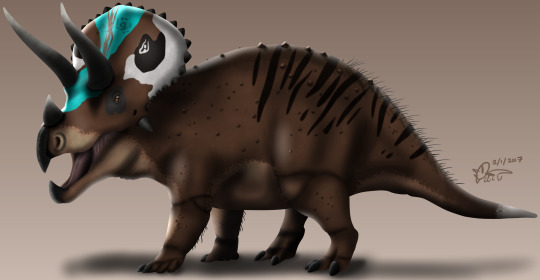
By Charles Nye on @ad-0rca-ble!
The first named Triceratops was thought to have been from the Pliocene, and thus, there’s the funny fluke of Triceratops first being called a bison, which is hilarious. Many other species have also been named, but only T. horridus and T. prorsus remain. It is known from the Hell Creek Formation in Montana, the Evanston Formation of Wyoming, the Scollard Formation of Alberta, the Laramie Formation of Colorado, the Lance Formation of Wyoming, and the Denver Formation of Colorado - so the general northwestern United States and southwestern Canada region. It lived alongside many other dinosaurs, most famously Tyrannosaurus, which probably preyed upon it; in fact, there are remains of Triceratops horns and skulls with tyrannosaur tooth marks and new growth after breakage, indicating the dinosaurs encountered - the Tyrannosaurus hunting the Triceratops - and the Triceratops walked away.

By Jack Wood on @thewoodparable
Triceratops also shows extensive evidence of intra-specific combat, with a hole found in one skull that matches up with the horns of Triceratops, which was also healed, indicating that the two individuals fought one another. Studies of wounds found in skulls have also indicated that Triceratops not only probably engaged in intraspecific combat, but also used its frill as a defenseve mechanism against predators, given it’s relatively robust structure (compared to other Ceratopsians). In addition, like in other Ceratopsians, it probably doubled as a display structure, to intimidate other members of the species, distinguish between species, and to attract mates.
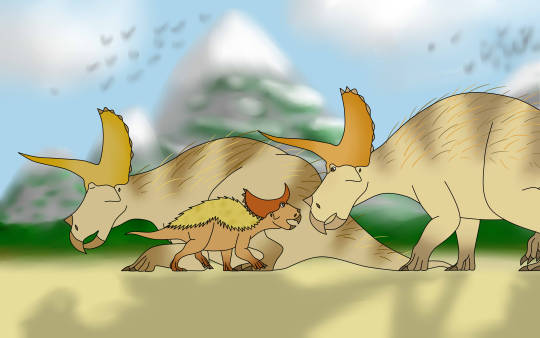
By Jem McCormick on @excessively-english-little-b
Though it is often depicted as living in herds, almost all remains of Triceratops are known from solitary individuals; groupings of juveniles are known, but bonebeds of Triceratops are rare. This would indicate that they did not, in fact, live in large herding groups like modern bison - but may have been mostly solitary like modern rhinoceros. Small family groups have also been found, of varying individuals of varying ages, indicating that it seems likely that they lived in small family groups. What composition these family groups were in is uncertain - they could have been mated pairs, or females grouping together to care for their young. (All I’m saying is, sapphic Triceratops are totally in the realm of possibility. Like the two lovely ladies above.)
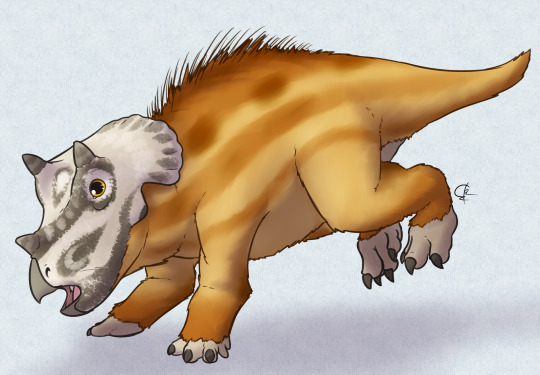
By José Carlos Cortés on @ryuukibart
Much is known about the life cycle of this animal, with many individuals from various ontogenetic stages known. Babies, juveniles, subadults, and adults are all known, showing a clear progression through life - from the babies having diminished horns and frill, to the juveniles growing those features out, including developing triangle-like osteoderms on the frill. This is an extensive amount of change already seen in bone development and growth, and it highly varied between individuals, with many growing longer or more curved horns, bigger frills, and even frill without known projections around the side. Indeed, there’s so much variation in Triceratops individuals - and it is such a common animal in it’s time and formations - that scientists have a nasty habit of taking seemingly extra-unique Triceratops specimens and assigning them to new genera.

The gang’s all here! By Jack Wood, José Carlos Cortés, and Scott Reid; assembled by me
However, I’ve already covered the biggest question on that score in my Torosaurus entry, so I will leave that controversy at that. As for other dinosaurs that lived alongside Triceratops, there were indeed many: in Hell Creek especially, it lived alongside such dinosaurs as Acheroraptor and Dakotaraptor, Struthiomimus and Ornithomimus, Pectinodon and Paronychodon, Anzu and Leptorhynchos, Avisaurus and Brodavis, Ankylosaurus and Denversaurus, Leptoceratops and various probable- ontogenetic stages of Triceratops like Nedoceratops and Tatankaceratops and Torosaurus, Thescelosaurus and Edmontosaurus, Pachycephalosaurus and so many others. Similar collections of fauna were found in other formations it lived in, and it usually lived in forest and floodplain environments, where it would have eaten large amounts of fibrous plant material such as palms, cycads, and ferns.
Sources:
http://markwitton-com.blogspot.com/2015/12/dinosaur-scales-some-thoughts-for.html
https://en.wikipedia.org/wiki/Triceratops
Shout out goes to @inserthumanhere!
#triceratops#triceratops horridus#triceratops prorsus#dinosaur#ceratopsian#feathered triceratops#sapphic#inserthumanhere#palaeoblr#paleontology#prehistory#prehistoric life#dinosaurs#biology#a dinosaur a day#a-dinosaur-a-day#dinosaur of the day#dinosaur-of-the-day#science#nature#factfile#Dìneasar#דינוזאור#공룡#डायनासोर#ديناصور#ডাইনোসর#risaeðla#ڈایناسور#deinosor
140 notes
·
View notes
Text
Torosaurus latus, T. utahensis

By Jack Wood on @thewoodparable
PLEASE support us on Patreon! We really do need all of your support to keep this blog running - any amount helps!
Name: Torosaurus latus, Torosaurus utahensis
Name Meaning; Bull Reptile
First Described: 1891
Described By: Marsh
Classification: Dinosauria, Ornithischia, Genasauria, Neornithischia, Cerapoda, Marginocephalia, Ceratopsia, Neoceratopsia, Coronosauria, Ceratopsoidea, Ceratopsidae, Chasmosaurinae, Triceratopsini
Torosaurus is a somewhat controversial genus of Ceratopsian from various formations in the Northwestern United States and Southern Canada, including the Lance Formation, the Hell Creek Formation, and others. It lived in the latest part of the Cretaceous, about 68 to 66 million years ago, in the Maastrichtian age. It was about 7.9 to 9 meters long and had one of the largest Ceratopsian skulls, with a distinctively long, smooth and rounded frill without notable osteoderms. It had very long brow horns and a short nose horn, and holes in its frill that may have been used for display with different colors or patterns. It’s remains were fairly variable, with the brow horns curving in different ways or not even curving at all, and the frill occasionally curving as well. All specimens of Torosaurus, however, are identical to Triceratops in every way, except for the frill - though Torosaurus lack long nasal horns, plenty of Triceratops also lack this feature.

By José Carlos Cortés on @ryuukibart
So, what is the controversy?
Torosaurus may be an adult form of Triceratops - or, at least, an old-adult form. First things first: if that is true, Triceratops isn’t dead - it was named first, so Torosaurus would no longer be it’s own genus, and would be called Triceratops. So what’s the evidence for and against?
- The hypothesis is that, since dinosaurs didn’t reach full skeletal maturity until late in life, the “Torosaurus” morphotype for Triceratops would have only been found in some older individuals, rather than in typical adults. Since Triceratops has similarities to juvenile Ceratopsians, including it’s shorter frill, and given that Ceratopsians and other Marginocephalians (like Pachycephalosaurus) changed a lot as they grew, it seems reasonable that growing such a noticeably large frill would be a later stage in Triceratops growth.
- However, this hypothesis is far from proven. It has been pointed out that the differences in the frill between Torosaurus and Triceratops are not ones that typically happen during the growth of Ceratopsians - Triceratops would have needed to change a lot late in life. However, it is still not outside the realm of possibility, given the amount of change seen in the frill otherwise in Ceratopsians, and changes seen in other dinosaurs. Also, every specimen of Torosaurus seems to come from old individuals.

By Nobu Tamura, CC BY 3.0
- Torosaurus seems to be mainly found from the older parts of the Hell Creek Formation - in the same parts, or older parts than, Triceratops horridus, but it is older than Triceratops prorsus. It has also been proposed that Triceratops horridus really is two separate species: the oldest Hell Creek species, and the younger one. This would indicate that the Torosaurus in Hell Creek may represent the adult form of early Triceratops, with later Triceratops keeping their short frills in adulthood.
- The oldest known Torosaurus fossils are the least like Triceratops and do not overlap with Triceratops, however; in addition, Torosaurus utahensis lived much earlier than Torosaurus latus or any Triceratops, however, it is very poorly known and might not even be Torosaurus.
In the end, this is an ongoing debate - and one of the most interesting ones in Nonavian dinosaur paleontology. It’s really a toss up, and more studies are needed. Histological studies to look at the individual growth ages of various Torosaurus and Triceratops specimens - Stratigraphical studies to look at the temporal ages of the specimens and their spaciotemporal overlap - and studies into how much change is really reasonable for bones to undergo late in life. I personally think that Torosaurus is, indeed, the “old morph” for Triceratops - but the jury is out, and I encourage all of you to make your own conclusions by looking at the sources below.
Thanks to @fezraptor for helping me to summarize all of this (I’m not having a very good mental health day today).
Sources:
https://en.wikipedia.org/wiki/Torosaurus
Farke, A. A. 2011. Anatomy and Taxonomic Status of the Chasmosaurine Ceratopsid Nedoceratops hatcheri from the Upper Cretaceous Lance Formation of Wyoming, U.S.A. PLoS One: 6 (1): e16196.
Fowler, D. W., 2016. A new correlation of the Cretaceous formations of the Western Interior of the United States, I: Santonian-Maastrichtian formations and dinosaur biostratigraphy. PeerJ Preprints.
Longrich, N. R., and D. J. Field. 2012. Torosaurus is not Triceratops: Ontogeny in Chasmosaurine Ceratopsids as a Case Study in Dinosaur Taxonomy. PLoS One 7(2): e32623.
Maiorino, L., A. A. Farke, T. Kotsakis, and P. Piras. 2013. Is Torosaurus Triceratops? Geometric Morphometric Evidence of Late Maastrichtian Ceratopsid Dinosaurs. PLoS One 8(11): e81608.
Scannella, J. B., and J. R. Horner. 2010. Torosaurus Marsh, 1891, is Triceratops Marsh, 1889 (Ceratopsidae: Chasmosaurinae): synonymy through ontogeny. Journal of Vertebrate Paleontology 30 (4): 1157-1168
Scannella, J. B., and J. R. Horner. 2011. ‘Nedoceratops’: An Example of a Transitional Morphology. PLoS One 6(12): e28705.
Shout out goes to @rainbowbuttocks!
#torosaurus#torosaurus latus#torosaurus utahensis#dinosaur#ceratopsian#palaeoblr#rainbowbuttocks#paleontology#prehistory#prehistoric life#dinosaurs#biology#a dinosaur a day#a-dinosaur-a-day#dinosaur of the day#dinosaur-of-the-day#science#nature#factfile#Dìneasar#डायनासोर#ديناصور#ডাইনোসর#risaeðla#ڈایناسور#deinosor#恐龍#恐龙#динозавр#dinosaurio
124 notes
·
View notes
Text
Tatankaceratops sacrisonorum

By Scott Reid on @drawingwithdinosaurs!
PLEASE support us on Patreon! We really do need all of your support to keep this blog running - any amount helps!
Name: Tatankaceratops sacrisonorum
Name Meaning: Bison Horn Face
First Described: 2010
Described By: Ott & Larson
Classification: Dinosauria, Ornithischia, Genasauria, Neornithischia, Cerapoda, Marginocephalia, Ceratopsia, Neoceratopsia, Coronosauria, Ceratopsoidea, Ceratopsidae, Chasmosaurinae, Triceratopsini
Tatankaceratops is a small Triceratopsin known from the Hell Creek Formation in South Dakota, living about 66 million years ago, in the Maastrichtian age of the Late Cretaceous. Given it has small brow horns and a small frill, it is almost decidedly a juvenile Triceratops, and is just waiting for a paper to confirm it as such.
Source:
https://en.wikipedia.org/wiki/Tatankaceratops
Shout out goes to @lost-wytch!
#tatankaceratops#tatankaceratops sacrisonorum#dinosaur#ceratopsian#palaeoblr#lost-wytch#paleontology#prehistory#prehistoric life#dinosaurs#biology#a dinosaur a day#a-dinosaur-a-day#dinosaur of the day#dinosaur-of-the-day#science#nature#factfile#דינוזאור#Dìneasar#डायनासोर#ديناصور#ডাইনোসর#risaeðla#ڈایناسور#deinosor#恐龍#恐龙#динозавр#dinosaurio
82 notes
·
View notes
Text
Ojoceratops fowleri

By Jack Wood on @thewoodparable
PLEASE support us on Patreon! We really do need all of your support to keep this blog running - any amount helps!
Name: Ojoceratops fowleri
Name Meaning: Ojo Alamo Horn Face
First Described: 2010
Described By: Sullivan & Lucas
Classification: Dinosauria, Ornithischia, Genasauria, Neornithischia, Cerapoda, Marginocephalia, Ceratopsia, Neoceratopsia, Coronosauria, Ceratopsoidea, Ceratopsidae, Chasmosaurinae, Triceratopsini
Ojoceratops is a Ceratopsian from the Ojo Alamo Formation in New Mexico, living about 68 million years ago, in the Maastrichtian age of the Late Cretaceous. It was very similar to Triceratops but evidently had a more squared frill, but this is also found in some specimens of Triceratops and, as such, Ojoceratops is probably just another type of Triceratops, or at least ancestral and synonymous with Eotriceratops.
Source:
https://en.wikipedia.org/wiki/Ojoceratops
Shout out goes to @maybelaterr!
#ojoceratops#ojoceratops fowleri#dinosaur#ceratopsian#palaeoblr#maybelaterr#paleontology#prehistory#prehistoric life#dinosaurs#biology#a dinosaur a day#a-dinosaur-a-day#dinosaur of the day#dinosaur-of-the-day#science#nature#factfile#Dìneasar#डायनासोर#ديناصور#ডাইনোসর#risaeðla#ڈایناسور#deinosor#恐龍#恐龙#динозавр#dinosaurio#공룡
85 notes
·
View notes
Text
Regaliceratops peterhewsi

By Jack Wood on @thewoodparable
PLEASE support us on Patreon! We really do need all of your support to keep this blog running - any amount helps!
Name: Regaliceratops peterhewsi
Name Meaning: Royal Horn Face
First Described: 2015
Described By: Brown & Henderson
Classification: Dinosauria, Ornithischia, Genasauria, Neornithischia, Cerapoda, Marginocephalia, Ceratopsia, Neoceratopsia, Coronosauria, Ceratopsoidea, Ceratopsidae, Chasmosaurinae, Triceratopsini
Regaliceratops is a recently described Triceratopsin from the St. Mary River Formation in Alberta, living about 68 million years ago, in the Maastrichtian age of the Late Cretaceous. It helps to better understand the presence of Ceratopsians - specifically, Triceratopsins - in the latest Cretaceous, as so many Ceratopsians are from earlier, and yet Triceratops is one of the more important members of the Latest Cretaceous community. It was nicknamed Hellboy, both because of it’s distinctive horns, and because it was difficult to excavate. It has a distinctive frill with large horns on it, making it look like it had a crown; it’s brow horns were relatively small, though it’s nose horn was quite large. It is known from a fairly complete skull that was somewhat deformed from compression. It was about 5 meters long.
Source:
https://en.wikipedia.org/wiki/Regaliceratops
Shout out goes to @littlebitchsgaga!
#regaliceratops#regaliceratops peterhewsi#dinosaur#ceratopsian#palaeoblr#littlebitchsgaga#paleontology#prehistory#prehistoric life#dinosaurs#biology#a dinosaur a day#a-dinosaur-a-day#dinosaur of the day#dinosaur-of-the-day#science#nature#factfile#Dìneasar#דינוזאור#डायनासोर#ديناصور#ডাইনোসর#risaeðla#ڈایناسور#deinosor#恐龍#恐龙#динозавр#dinosaurio
70 notes
·
View notes
Text
Titanoceratops ouranos

By José Carlos Cortés on @ryuukibart
PLEASE support us on Patreon! We really do need all of your support to keep this blog running - any amount helps!
Name: Titanoceratops ouranos
Name Meaning: Titanic Horn Face
First Described: 2011
Described By: Longrich
Classification: Dinosauria, Ornithischia, Genasauria, Neornithischia, Cerapoda, Marginocephalia, Ceratopsia, Neoceratopsia, Coronosauria, Ceratopsoidea, Ceratopsidae, Chasmosaurinae, Triceratopsini
Titanoceratops is a Triceratopsin which may have had the longest skull of any land vertebrate, at 2.65 meters long. It’s entire body was about 6.8 meters long, making it an extremely large Ceratopsian, similar to Triceratops and Torosaurus. It was also very closely related to both, and is known from a partial skeleton and mostly complete skull. It is known from either the Kirtland or Fruitland Formations, the exact formation being unknown due to the Quarry being lost. Either way, it lived about 74 to 73 million years ago, in the Campanian age of the Late Cretaceous.
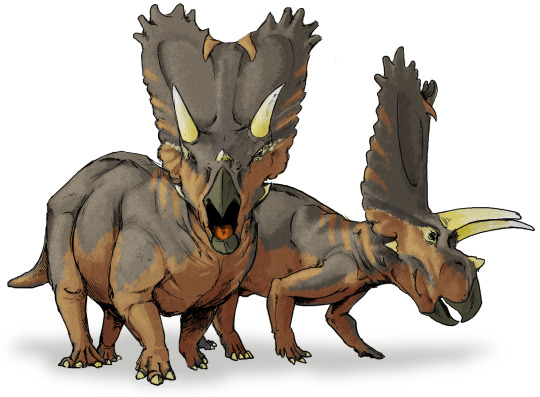
By Mariana Ruiz Villarreal, in the Public Domain
Titanoceratops was extremely similar to Eotriceratops and Ojoceratops, which lived at the same time; given the hypothesis that the short-frilled Triceratopsins were simply subadult forms of the longer-frilled forms like Titanoceratops, this seems fairly likely. More histological studies of the growth stages of Triceratopsins is necessary, of course, before this can be corroborated; I’ll be going over the “Toroceratops” controversy in the Torosaurus and Triceratops entries (though, just for the record: if Triceratops is a subadult form of Torosaurus, Triceratops was named first and would take priority. So Triceratops would stay, and Torosaurus would no longer be a valid name.) Still, Eotriceratops and Ojoceratops are both somewhat younger than Titanoceratops, so there is some doubt to the claim of their synonymy.

By Jack Wood on @thewoodparable
No matter which formation it lived in, Titanoceratops would have lived alongside a wide variety of dinosaurs such as Bistahieversor, which may have fed upon it; Saurornitholestes, Paronychodon, Anasazisaurus, Parasaurolophus, Stegoceras, Nodocephalosaurus, and Pentaceratops. It was originally thought to be a species of Pentaceratops before being separated out from it. Titanoceratops is also unique in its size by showing that large Ceratopsians were evolving earlier than the time of Triceratops and Torosaurus, and also does close at least a little of the gap between these forms in the evolutionary tree.
Source:
https://en.wikipedia.org/wiki/Titanoceratops
Shout out goes to @existential-dinosaur!
#titanoceratops#titanoceratops ouranos#dinosaur#ceratopsian#palaeoblr#existential-dinosaur#Dìneasar#डायनासोर#ديناصور#ডাইনোসর#risaeðla#ڈایناسور#deinosor#恐龍#恐龙#динозавр#dinosaurio#공룡#דינוזאור#paleontology#prehistory#prehistoric life#dinosaurs#biology#a dinosaur a day#a-dinosaur-a-day#dinosaur of the day#dinosaur-of-the-day#science#nature
77 notes
·
View notes
Text
Kosmoceratops richardsoni

By Jack Wood on @thewoodparable
PLEASE support us on Patreon! We really do need all of your support to keep this blog running - any amount helps!
Name: Kosmoceratops richardsoni
Name Meaning: Ornament Horn Face
First Described: 2010
Described By: Sampson et al.
Classification: Dinosauria, Ornithischia, Genasauria, Neornithischia, Cerapoda, Marginocephalia, Ceratopsia, Neoceratopsia, Coronosauria, Ceratopsoidea, Ceratopsidae, Chasmosaurinae
Kosmoceratops is one of the more interesting Chasmosaurines due to its frontward folded over frill osteoderms, giving it a very distinctive frill shape. It also had long, thin, pointed horns that go horizontally on its face. Both of these differ from most ceratopsians - the brow horns usually are forward or backward oriented, and the frill osteoderms are usually not so dramatically hooked, and usually the frill is longer in other Chasmosaurines. The positioning of its horns would not have been particularly useful for defense, so both of these unique structures probably were used for display. It was found in the Kaiparowits Formation in Utah, living about 76 to 75 million years ago, in the Campanian age of the Late Cretaceous. It was a relatively early derived Chasmosaurine, and it lived alongside such dinosaurs as Gryposaurus, Nasutoceratops, Parasaurolophus, Utahceratops, Avisaurus, Hagryphus, Ornithomimus, Richardoestesia, Talos, Teratophoneus, and Troodon.
Sources:
https://en.wikipedia.org/wiki/Kaiparowits_Formation
https://en.wikipedia.org/wiki/Chasmosaurinae
https://en.wikipedia.org/wiki/Kosmoceratops
Shout out goes to @eileendoodles!
#kosmoceratops#kosmoceratops richardsoni#dinosaur#ceratopsian#palaeoblr#eileendoodles#paleontology#prehistory#prehistoric life#dinosaurs#biology#a dinosaur a day#a-dinosaur-a-day#dinosaur of the day#dinosaur-of-the-day#science#nature#factfile#Dìneasar#डायनासोर#ديناصور#ডাইনোসর#risaeðla#ڈایناسور#deinosor#恐龍#恐龙#динозавр#dinosaurio#공룡
180 notes
·
View notes
Text
Utahceratops gettyi

By Jack Wood on @thewoodparable
PLEASE support us on Patreon! We really do need all of your support to keep this blog running - any amount helps!
Name: Utahceratops gettyi
Name Meaning: Utah Horned Face
First Described: 2010
Described By: Sampson et al.
Classification: Classification: Dinosauria, Ornithischia, Genasauria, Neornithischia, Cerapoda, Marginocephalia, Ceratopsia, Neoceratopsia, Coronosauria, Ceratopsoidea, Ceratopsidae, Chasmosaurinae, “Chasmosaurini”
(Note: Chasmosaurini is not a valid clade name, rather an informal name I have given to those Chasmosaurines found to be more closely related to Chasmosaurus than to Triceratops in the phylogeny of Brown et al., 2014)
Utahceratops is a close relative of Pentaceratops, with specimens only known from - you guessed it - Utah, specifically the Kaiparowits Formation. It lived about 76 to 74 million years ago in the Campanian age of the Late Cretaceous, quite close to the western interior seaway. It lived in an ancient floodplain with large channels and wetland peat swamps, bordered by highlands. Utahceratops itself was about 7 meters long, with short brow horns somewhat splayed apart, and a longer nose horn. It was about 2 meters high and lived alongside many other dinosaurs, such as Talos, Teratophoneus (which probably preyed upon it), Parasaurolophus, Gryposaurus, Nasutoceratops, Kosmoceratops, and Hagryphus.
Sources:
https://en.wikipedia.org/wiki/Utahceratops
https://en.wikipedia.org/wiki/Chasmosaurinae
Shout out goes to @marthalerma!
#utahceratops#utahceratops gettyi#dinosaur#ceratopsian#palaeoblr#marthalerma#paleontology#prehistory#prehistoric life#dinosaurs#biology#a dinosaur a day#a-dinosaur-a-day#dinosaur of the day#dinosaur-of-the-day#science#nature#factfile#Dìneasar#डायनासोर#ديناصور#ডাইনোসর#risaeðla#ڈایناسور#deinosor#恐龍#恐龙#динозавр#dinosaurio#공룡
81 notes
·
View notes
Text
Polyonax mortuarius

By José Carlos Cortés on @ryuukibart
PLEASE support us on Patreon! We really do need all of your support to keep this blog running - any amount helps!
Name: Polyonax mortuarius
Name Meaning: Master Over Many
First Described: 1874
Described By: Cope
Classification: Dinosauria, Ornithischia, Genasauria, Neornithischia, Cerapoda, Marginocephalia, Ceratopsia, Neoceratopsia, Coronosauria, Ceratopsoidea, Ceratopsidae, Chasmosaurinae, Triceratopsini
Polyonax is a very poorly known Ceratopsian that, at least, has one of the coolest dinosaur names I’ve heard of yet. It was found in the Denver Formation of Colorado, living about 66 million years ago, in the Maastrichtian age of the Late Cretaceous. It is known from parts of the vertebrae and horn cones, which at least identify it as a subadult. Given the paucity of remains, it is uncertain whether or not it actually is the same genus as, say, Triceratops; it is listed as a Triceratopsin merely because of it’s late position in the fossil record.
Source:
https://en.wikipedia.org/wiki/Polyonax
Shout out goes to @steveabecker!
#polyonax#polyonax mortuarius#dinosaur#ceratopsian#palaeoblr#paleontology#prehistory#prehistoric life#dinosaurs#biology#a dinosaur a day#a-dinosaur-a-day#dinosaur of the day#dinosaur-of-the-day#science#nature#factfile#steveabecker#Dìneasar#डायनासोर#ديناصور#ডাইনোসর#risaeðla#ڈایناسور#deinosor#恐龍#דינוזאור#恐龙#динозавр#dinosaurio
37 notes
·
View notes